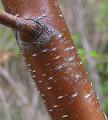Water Birch Tree Information
Images of Water Birch:






Water Birch grows in the following 19 states and provinces:
Alaska, Alberta, British Columbia, California, Colorado, Idaho, Manitoba, Montana, Nebraska, Nevada, North Dakota, Northwest Territories, Oregon, Saskatchewan, South Dakota, Utah, Washington, Wyoming, YukonInformation about Water Birch:
The Betula Occidentalis is commonly known as the Black Birch, Mountain Birch, Red Birch, Rocky Mountain Birch, Spring Birch as well as Water Birch.
The currently accepted scientific name of water birch is Betula occidentalis Hooker . There are no recognized subspecies, varieties, or forms. In eastern Washington, northeastern Oregon, western Idaho, and southern British Columbia, water birch hybridizes with paper birch (Betula papyrifera) producing many intermediate forms which appear to be well established locally . Water birch is distributed from southern Alaska to southern Manitoba and North Dakota, and south to southern California and New Mexico . It is absent along the Pacific Coast mountain ranges . In California, water birch is found mainly on the east side of the southern Sierra Nevada Mountains, with only a few isolated colonies on the west side , and is mostly lacking from the central and northern Sierra Nevada Mountains .Water birch is most often found in riparian woodland communitiesqq characterized by cottonwoods (Populus spp.), willows (Salix spp.), alders (Alnus spp.), and box elder (Acer negundo) . These communities often occur as narrow bands adjacent to streams on alluvial terraces throughout the mountainous West in the Douglas-fir (Pseudotsuga menziesii), ponderosa pine (Pinus ponderosa), or Engelmann spruce (Picea engelmannii) zones but may extend well into big sagebrush (Artemisia tridentata) flats . Water birch also grows in riparian communities in the Mojave Desert of California . In North Dakota, aspen (Populus tremuloides)/water birch habitat types are found on relatively steep northeast- to east-facing slopes of upland ravines . Published classification schemes listing water birch as a dominant part of the vegetation in community types (cts), habitat types (hts), riparian site types (rst), or dominance types (dts) are presented below. Area Classification Authority ND: Theodore general veg. hts Hansen, Hoffman, Roosevelt Natl Park and Bjugstad 1984 seMT,swND,nwSD,neWY: upland forest & Hansen, Hoffman, Missouri Plateau woodland veg. hts and Steinauer 1984 MT,WY: Bighorn Canyon general veg. cts Knight & others 1987 Natl Rec Area WY riparian veg. cts Olson and Gerhart 1982 CO general veg. cts Baker 1984 MT riparian veg. dts Hansen, Chadde, and Pfister 1988 swMT riparian veg. rst,cts,hts Hansen, Pfister, Joy 1989Some of the information provided here is attributed to:Uchytil, Ronald J. 1989. Betula occidentalis. In: Fire Effects Information System, [Online]. U.S. Department of Agriculture, Forest Service, Rocky Mountain Research Station, Fire Sciences Laboratory (Producer). , available at the USDA Fire Effects Information System (FEIS) website